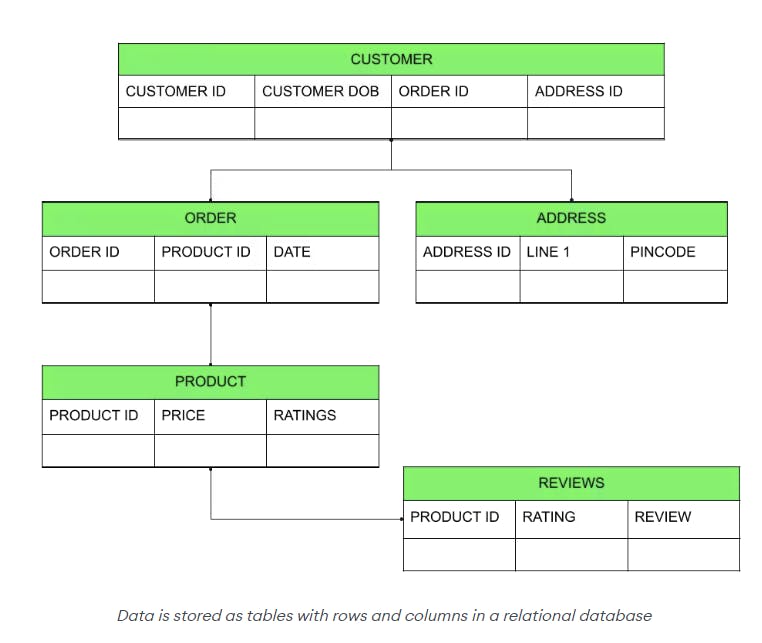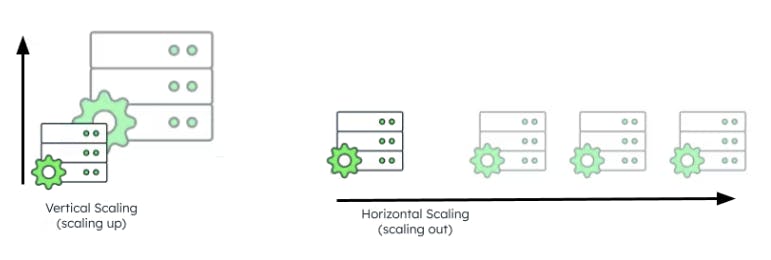관계형 데이터베이스는 고정된 스키마를 사용하여 생성 및 관리된다는 점에 유의해야 합니다. 고정된 스키마는 데이터베이스에 수집되는 모든 데이터를 관계형 데이터베이스가 저장할 수 있는 데이터 구조 유형을 제한하는 사전 정의된 형식 지정 표준에 정확하게 맞춰야 함을 의미합니다. 예를 들어 관계형 데이터베이스는 비정형 데이터(예: 형식이 일관적이지 않고 사전 설정된 데이터 모델에 맞지 않는 정보)를 처리할 수 없지만 정형 데이터나 반정형 데이터 유형(예: 형식이 일관적이고 사전 설정된 데이터 모델에 맞는 데이터)이 포함된 거래 정보나 재무 정보를 지원하는 데는 탁월합니다.
SQL 데이터베이스 예시
다음과 같은 다양한 SQL 데이터베이스 예시가 있습니다:
- Oracle: Oracle 데이터베이스는 Oracle Corporation에서 개발 및 판매하는 RDBMS(관계형 데이터베이스 관리 시스템)로, 세계에서 가장 일반적으로 사용되는 엔터프라이즈 데이터베이스 시스템 중 하나입니다.
- MySQL: MySQL은 데이터베이스를 만들고 관리하는 데 일반적으로 사용되는 오픈 소스 관계형 데이터베이스 관리 시스템입니다. Oracle Corporation에서 개발 및 배포하는 MySQL은 사용 편의성, 광범위한 커뮤니티 지원 및 안정성으로 유명합니다.
- 참고: MySQL의 오픈 소스 대안으로는 Oracle Corporation이 MySQL을 인수한 후 MySQL을 대체하기 위해 설계된 MariaDB가 있습니다.
- PostgreSQL: PostgreSQL은 SQL의 기능을 확장하는 풍부한 고급 기능으로 유명한 오픈 소스 객체 관계형 데이터베이스 관리 시스템입니다. 버클리 캘리포니아 대학교의 POSTGRES 프로젝트의 일환으로 개발된 PostgreSQL은 복잡한 데이터 워크로드를 안전하게 저장하고 확장하는 ACID 호환 기능을 제공합니다(PostgreSQL.org 2024).
- MSSQL: MSSQL은 Microsoft SQL Server의 약자로, Microsoft에서 개발한 관계형 데이터베이스 관리 시스템입니다. 이 데이터베이스 플랫폼은 일반적으로 대규모 엔터프라이즈 환경에서 대량의 트랜잭션 처리, business intelligence, 분석 애플리케이션을 지원하는 데 사용됩니다.
- SQLite: 이 목록의 다른 예시와 달리 SQLite는 사실 RDBMS를 제공하는 소프트웨어 라이브러리입니다. 이 목록의 다른 RDBMS와 달리 SQLite는 서버리스이며 구성이 필요 없는 독립형입니다. 이는 SQLite를 사용하여 애플리케이션에 내장되므로 별도의 서버가 필요하지 않기 때문입니다.
다른 유형의 데이터베이스도 데이터 간의 관계를 설정할 수 있다는 점에 유의하세요. 정규화된 테이블 형식 데이터베이스(예: SQL 또는 관계형 데이터베이스)의 경우 이러한 관계는 외래 키나 교차 테이블을 사용하여 표현됩니다. MongoDB와 같은 DBMS(데이터베이스 관리 시스템)의 경우(예: NoSQL 데이터베이스) 이러한 관계는 데이터를 포함하거나 참조하여 설정됩니다.
NoSQL(Not only Structured Query Language)
NoSQL이란 무엇인가요?
NoSQL은 Not only SQL의 약자로, 데이터베이스 내에서 비정형 데이터와 반정형 데이터를 수집, 저장, 조회하는 데 사용되는 데이터베이스 관리 시스템 접근 방식입니다. 즉, 기존의 관계형 데이터베이스(예: SQL)를 통해 분석하거나 계산할 수 없는 데이터를 네이티브 형식으로 유지하고 NoSQL 데이터베이스에 수집할 수 있습니다. NoSQL이라고 부르는 이유는 이러한 데이터베이스가 테이블 형식이 아닌 비관계형 데이터 모델을 처리할 수 있을 뿐만 아니라 SQL과 유사한 쿼리 언어를 지원할 수 있다는 점을 강조하기 위해서입니다.
비정형 데이터란 무엇인가요?
비정형 데이터는 사전 정의된 데이터 모델이나 일관적인 구성이 없는 데이터입니다. 또한 소셜 미디어 게시물과 같은 비정형 데이터는 빠르게 업데이트되고 변경될 수 있는 반면, 은행 거래와 같은 정형 데이터는 변경 속도가 훨씬 느립니다. 비정형 데이터의 예로는 사진, 오디오 파일, 동영상, 지도 등이 있습니다.
NoSQL 데이터베이스란 무엇인가요?
NoSQL 데이터베이스는 비정형 데이터와 반정형 데이터를 수용하는 유연한 스키마를 활용하는 동시에 테이블 형식이 아닌 데이터 저장 방식을 활용하는 데이터베이스입니다.
유연한 스키마를 사용하면 NoSQL 데이터베이스가 비정형 데이터를 네이티브 형식(예: .txt, .JPG, MP3)으로 수집할 수 있는데, 이는 모든 데이터를 사전 정의된 형식에 맞춰야 하는 SQL 데이터베이스에서는 불가능한 일입니다. 또한 NoSQL 데이터베이스는 데이터를 저장할 때 유연한 데이터 모델을 사용하므로 비정형 데이터 파일이 서로 다른 데이터 구조를 가지면서도 동일한 컬렉션 내에 저장될 수 있습니다.
자세한 내용은 NoSQL 데이터베이스에 대한 튜토리얼을 따르세요.
NoSQL 데이터베이스 유형
NoSQL 데이터베이스에는 다음과 같은 여러 유형이 있습니다.
- 문서 데이터베이스: 문서 데이터베이스는 객체 지향 데이터베이스라고도 하며, JSON(JavaScript Object Notation) 객체와 유사하지만 JSON 스토어는 아닌 문서에 데이터를 저장합니다. 네이티브 객체에서 개발자가 사용하는 프로그래밍 언어로 반환된 드라이버를 사용하므로 ORM(객체 관계 매퍼)이 필요하지 않습니다. 각 문서 자체는 레코드로 취급되며 숫자, 배열, 객체, 문자열 또는 부울 문자 등의 값을 포함할 수 있습니다. 또한 키-값 쌍, 중첩된 문서 또는 기타 정형 데이터도 포함할 수 있습니다. 이러한 NoSQL 데이터베이스의 인기 있는 제공자는 MongoDB입니다.
- 키-값 데이터베이스: 키-값 데이터베이스는 데이터를 키-값 쌍의 그룹으로 수집, 조회, 저장합니다. 즉, 각 데이터 레코드는 고유 키와 연관된 값으로 표현됩니다. 키는 데이터베이스에서 해당하는 값을 조회하는 데 사용됩니다. 예를 들어 인테리어 디자인 키-값 데이터베이스에서 키는 '색상', 값은 '보라색'일 수 있습니다. 이러한 NoSQL 데이터베이스 시스템의 인기 있는 제공자로는 AWS와 ScyllaDB가 있습니다.
- 컬럼-패밀리 스토어: 컬럼 패밀리 데이터베이스는 데이터를 행이 아닌 열으로 구성하므로 깊이가 희박한 광범위한 데이터 세트로 작업할 때 유용합니다. 실제로 컬럼-패밀리 스토어는 '와이드 컬럼 스토어'라고도 합니다. 컬럼-패밀리 스토어에서 각 행에는 서로 다른 열 세트가 있으며, 열은 '패밀리'로 모입니다. 이러한 데이터 모델은 성능을 최적화하기 위해 수평적 확장의 이점이 있는 대규모 데이터 세트로 작업할 때 유용합니다. 이러한 NoSQL 데이터베이스의 인기 있는 제공자로는 Apache Cassandra와 HBase가 있습니다.
- 그래프 데이터베이스: 그래프 데이터베이스는 노드와 에지에 데이터를 저장합니다. 노드에는 일반적으로 사람, 장소 및 사물에 대한 정보가 저장되고, 에지에는 노드 간의 관계에 대한 정보가 저장됩니다. 그래프 데이터베이스는 그래프 구조(예: 소셜 네트워크, 계층 구조)를 쿼리하는 데 탁월한 도구입니다. 이러한 NoSQL 데이터베이스의 인기 있는 제공자로는 Neo4j, AWS, Kibana가 있습니다.
SQL과 NoSQL 데이터베이스 간의 주요 차이점
SQL 데이터베이스와 NoSQL 데이터베이스 모두 유용한 기능을 제공하지만, 두 데이터베이스 간의 주요 차이점을 이해하는 것이 중요합니다.
데이터베이스 저장 모델
데이터 저장과 관련된 SQL과 NoSQL 데이터베이스 시스템 간의 차이점은 극명합니다. 구체적으로 SQL 데이터베이스는 행과 열이 포함된 테이블에 데이터를 저장하는 반면 NoSQL 시스템은 수집되는 비정형 데이터의 유형에 따라 다양한 방법(예: JSON 문서, 키-값 쌍, 패밀리 그룹화, 그래프 노드/에지)을 사용하여 데이터를 저장합니다.
데이터 유형
비관계형 데이터베이스라고도 하는 NoSQL 데이터베이스는 비정형 데이터를 수집, 저장, 조회할 수 있는 반면, SQL 데이터베이스(예: 기존 관계형 데이터베이스)는 그렇지 않습니다. SQL 데이터베이스는 정형 데이터만 수집, 저장, 조회할 수 있습니다. 이는 사용되는 SQL 스키마와 NoSQL 스키마 간의 차이 때문입니다.
스키마
SQL 데이터베이스는 수집되는 데이터를 맞춰야 하는 엄격한 사전 정의된 데이터 스키마를 사용합니다. 그러나 NoSQL 데이터베이스는 유연한 스키마를 사용하여 다양한 네이티브 형식으로 데이터를 수집할 수 있습니다.
확장성
데이터베이스 관리자가 데이터베이스 시스템의 성장과 확장을 계획하는 것이 중요합니다. 이는 SQL과 NoSQL 데이터베이스 간의 또 다른 분명한 차이점입니다.

